skip to main |
skip to sidebar
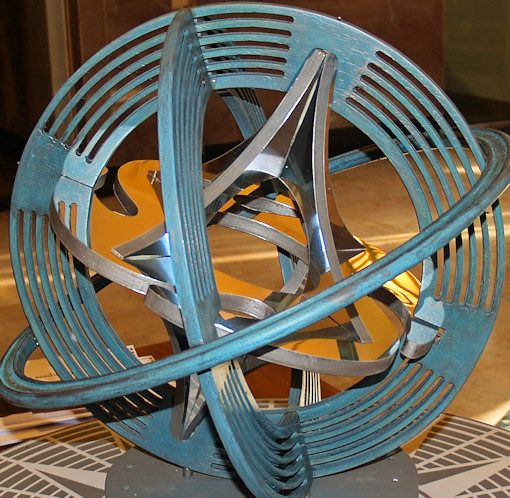 By sometime in 2011, Oklahoma City will have a beautiful new sculpture to look at in Bicentennial Park east of the Civic Center Music Hall and easily viewable west of Walker. Click the photos in this article for a larger views. On Tuesday, March 30, 2010, the Oklahoma City Council approved a plan being 100% funded by a $350,000 grant from the Inasmuch Foundation to construct and install the the 30-foot diameter sculpture named "Compass Rose." The sculptor is New York artist Owen Morrel. What you're seeing above and below are photos I took at City Hall yesterday before the transit meeting which I reported on yesterday. 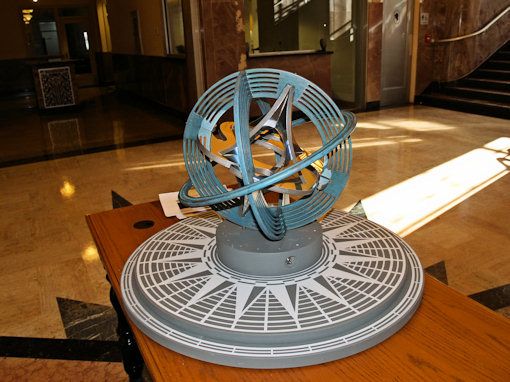
A packet of realistic looking images were available near the model and I'll show some of those images below. When I took the above pics and picked up the packet, I didn't know what it was all about, but today's Oklahoman carried a short article by Tim Henley which describes the action taken by the City Council.
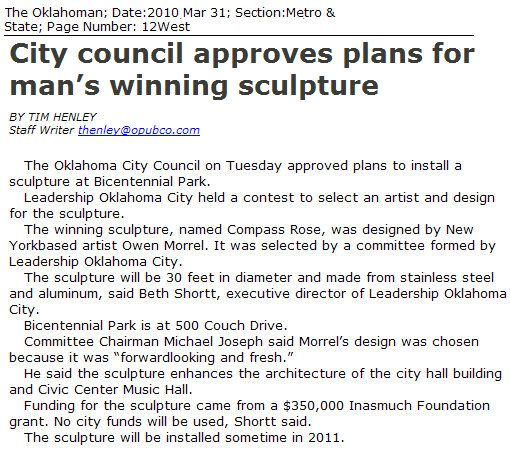
The information below was scanned from the packet and gives some background and cost detail:

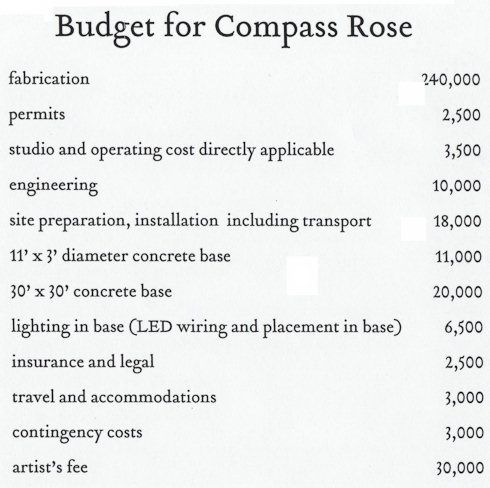
I don't fully know the history behind this project but I've found a little. In an October 21, 2009, Staff Report to the city's Park Commission, it is noted that on May 16, 2007, Leadership Oklahoma City (LOKC) presented a proposed Bicentennial Park and City Hall Area Master Plan to the city's Park Commission and, further, that,
The Department has been notified that LOKC has selected an artwork by Artist Owen Morrel to be placed in Bicentennial Park, funded by a $350,000 grant from the Inasmuch Foundation * * *.
* * *
The proposed artwork selection by LOKC has been placed on the October 19, 2009 Oklahoma City Arts Commission agenda for a recommendation to the City Council. The decision of the Arts Commission will be communicated by staff to the Park Commission during the meeting. The sixty-year old sculptor has crafted a substantial body of public art and you can find out about the award winning Morrel at his website and view photos of some of his other work here.
The packet of materials by the model of Compass Rose shows these views of how the completed project will look. Click on them for larger views.
Artist's Description

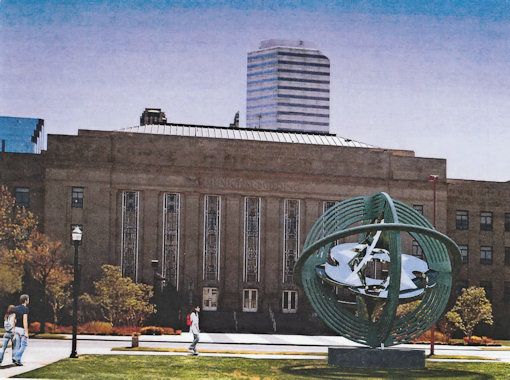
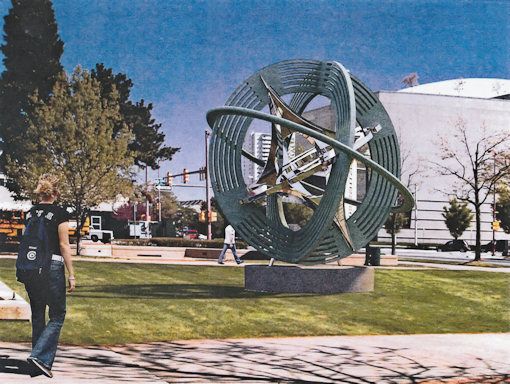
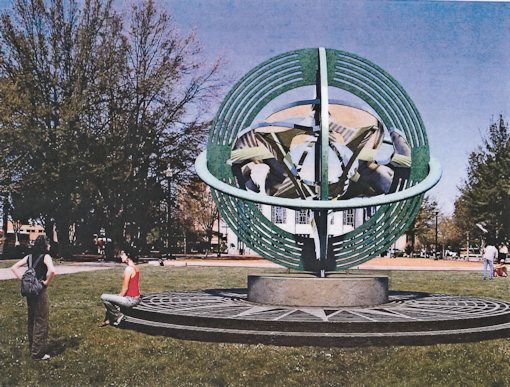
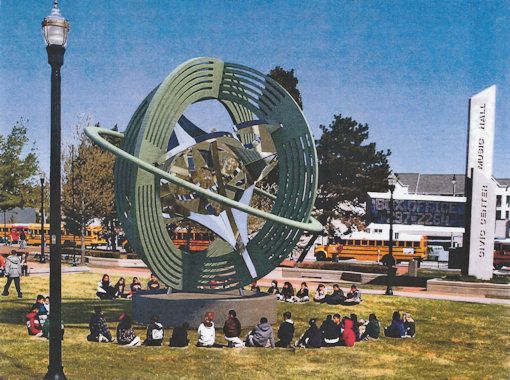
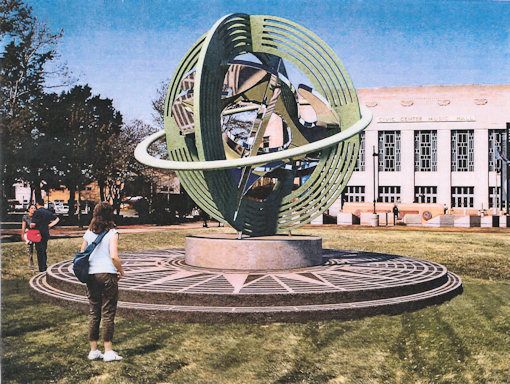
Night Scene -- LED lights in base illuminate at night
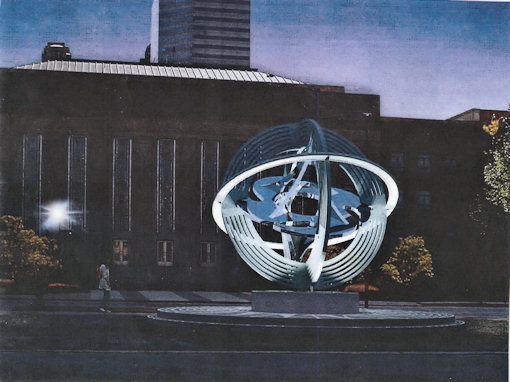
Go To Top
... Click here to read the full article and any comments ...
Following up on the theme of last article on 1st National & Bunky and with the same emphasis on the early days before and after the April 22, 1889, Land Run, during a recent insomniac event I went to Hulu to see what I could watch there while I should have been sleeping but could not. There, I ran across a popular movie, McLintock, released in 1963 starring John Wayne and Maureen O'Hara. It being a movie I'd enjoyed many years earlier, I selected it to watch and I'm glad that I did.  But not until that viewing did it sink in that McLintock might be a movie about Oklahoma, scripted as it was in the nature of a historical novel. That glimmer led me to research a bit more and the result is this post which I hope that you will enjoy, in addition to the movie itself. The result of my investigation led me to conclude and say without any hesitation that McLintock is a comedic western tale which has Oklahoma Territory as its setting, and the parts of the story which are presented as historic fact are solidly accurate. The story line itself is based on William Shakespeare's Taming of the Shrew ala John Wayne's unmistakable style.
Below, I'm presenting for your viewing a condensed slide-show of the movie without audio which lasts 8-9 minutes but which contains controls so that you can move around or end watching as you will. I've assembled this from 100+ screen captures within the real movie. It contains a summary annotations as well as historical notes along the way. Below that, I've embedded the full 2-hour movie from Hulu's website, for as long as it remains available there. After that, I've added some notes about how the movie measures up to real Oklahoma history. Have fun and enjoy the show!
Doug Dawgz Cut
Click on the graphic to start the 8-9 minute slide show
containing historical notes and the movie summary
McLintock, the Movie
An Oklahoma Territory adaptation of Taming of the Shrew
The 2-Hour Full Movie
From Hulu, for as long as remains available there -- sometimes it isn't
A no-commercial but not wide-screen version is also available at the link below:
Click Here To Play McLintock At The Alternate Location
The Real History. Even though McLintock is an adaptation of William Shakespeare's Taming of the Shrew and the story itself is fictional, the story's setting is based upon accurate historical Oklahoma facts.
Click below for a brief 6 minute slide show which explains that.
Go To Top
... Click here to read the full article and any comments ...
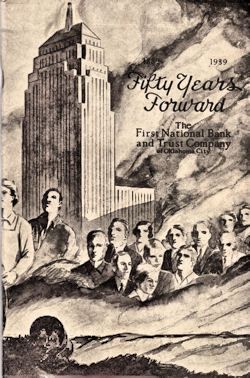 In 1939 the 1st National Bank published an excellent 64 page booklet called Fifty Years Forward which not only commemorated its 50th anniversary as an Oklahoma City banking institution but also contained lengthy excerpts from "Bunky's" The First Eight Months of Oklahoma City (McMaster Printing Company 1890), a then-contemporary history of Oklahoma City's 1st 8 months, published in 1890. This booklet is one of the neat purchases I made at the Abalache Book Shop on Exchange Avenue a couple of weeks ago. This article presents all 64 pages of 1st National's commemorative booklet. Beyond that, it presents information about Bunky and contains the full content of his 1890 publication. To read all of Bunky's work, go to this later post for the full booklet. Fifty Years Forward. 1st National's booklet consists of two parts. First, following a brief introduction, pages 3-45 contain excerpts from the booklet, The First Eight Months of Oklahoma City by "Bunky" (McMaster Printing Company 1890). Second, pages 46-64 trace the history of the First National Bank from the Land Run through 1939. Every page in the booklet contains either a drawing of a historical scene, building, or person, OR it contains a photograph of 1st National as it existed in and around 1939.
The constraints of blogger software aren't good for presenting larger scale single-topic presentations like this one is meant to be. My work-around is to create files external to the blog which present 1st National's booklet in both HTML and PDF formats both of which are linked to in this article, after the explanation below.
The HTML presentation contains a home page with links to each separate page, allowing you to move page by page through the booklet.
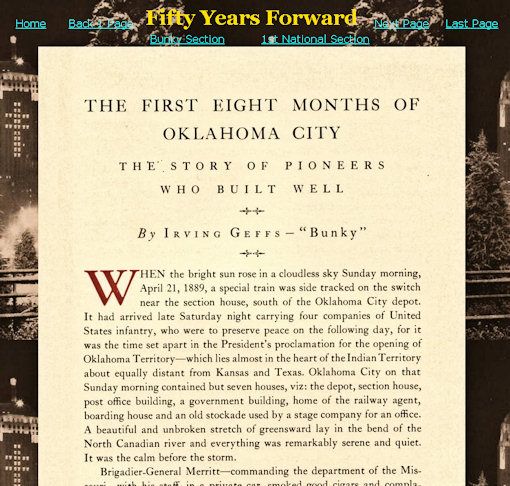
The PDF version is fully bookmarked and presents everything in a single file and one that you can save to your computer. It is best for printing should you want to do that. But it is large ... 34.5 MB ... and it will take some time to download.
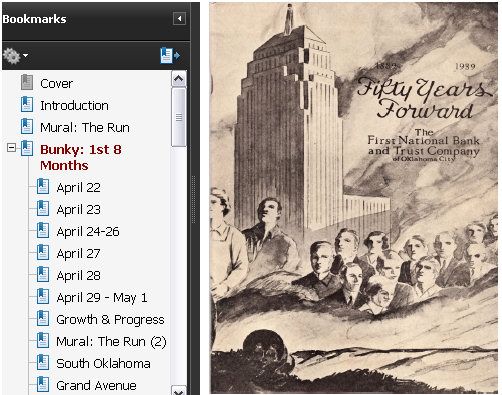
Click a link below for what you want to do ...
Open HTML version Open PDF version
Only Look at Photos Just Read Bunky's Stuff
Photos From Fifty Years Forward. In addition to the sketches of people, places, and events shown on each page, the booklet contains eight photos showing First National (or its president) in 1939. Click on any small image below for a 1024 px wide version of the same.1st of 4 Cameron Murals
The Run
 | 2nd of 4 Cameron Murals
The Run
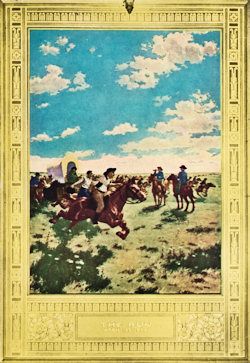 | 3rd of 4 Cameron Murals
Louisiana Transfer
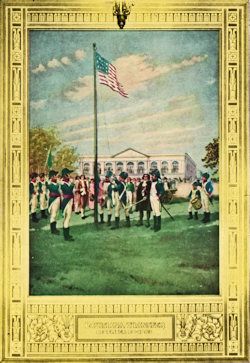 | 4th of 4 Cameron Murals
Sunset Trail
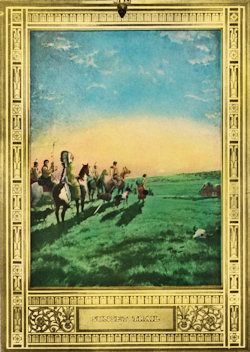 | Christmas At Night
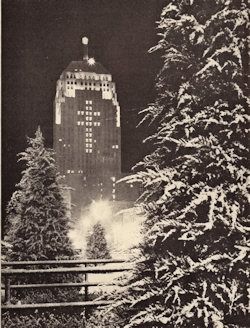 | 1st National
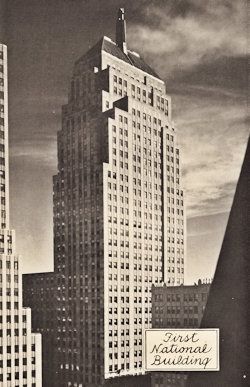 | Hugh M. Johnson, President
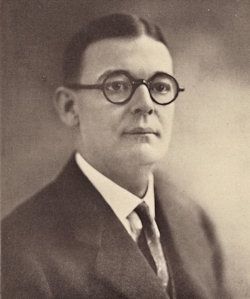 | Great Banking Hall
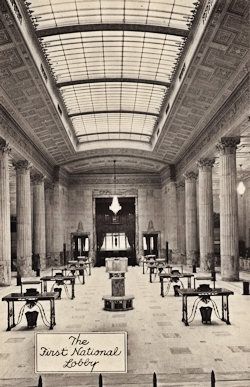 |
Full Text of Bunky's First Eight Months of Oklahoma City. First things first: Who Was Bunky? The author's real name was Irving Geffs. Luther B. Hill's 1908 A History of the State of Oklahoma, Vol. I (1908), pages 218-219, says this about the author of First Eight Months of Oklahoma City:
This unique little book, printed at Oklahoma City in 1890, containing 110 pages in pamphlet form, was written by "Bunky," and aside from this name the historian gave no hint of his own individuality. His real name was Irving Geffs. Some time before the incidents which he describes he had taken too much liquor, and on recovering his senses found that he was a regularly enlisted soldier of the United States army, a position for which he had no special liking, but it was several years before he was able to get out. He was with the infantry that camped at Oklahoma City the day before the opening, and on leaving the army remained in the city for some time. He was a left-handed scribe, a clever writer, and was in the employ of some of the first newspapers of the city, especially with Frank McMaster. McMaster was publisher of early-day newspaper, The Oklahoma Gazette, and was publisher of Bunky's booklet.
A reader of Bunky's work would do well to differentiate between what Bunky reports as fact and what he reports as opinion. It is easy enough for an objective reader to see that he was a "homer" – his reports are much too glowing and also report much too little on any negative aspects of the 1st 8 months in Oklahoma City to be taken at face value as literally correct. He also wholly misstates facts in at least one instance -- his closing description of the attempt to create a successful electricity-producing canal was written as though it was a huge success, but the truth is that it proved to be a huge failure. So, read Bunky with your eyes wide open.
Readers should understand that the PDF file linked to below may not exactly contain the exact original document published by McMaster Printing Company in 1890, even if it almost completely does so. After the 1890 publication, the work was republished in 1939 by the Trave-Taylor Company, and, most recently in 1989 was republished by HISTREE in a rendition by Larry S. Watson. Excerpts from the original document appear in various sources, notably in the First National Bank's Fifty Years Forward in 1939.
The original was also republished in 1988 by the Women's Posse of the Westerners and since writing this piece I've come to own a copy, have scanned it, and it is available for you here.
Additionally, at www.okgenweb.org/books/okc/index.htm, Bill Hallman has reduced to text what is presumably (although it is not so stated) the original version of the booklet — and from Hallman's rendition the file produced here, with substantial formatting and modest technical corrections, is derived and is presented.
Click here to open the PDF file, or click the image below.
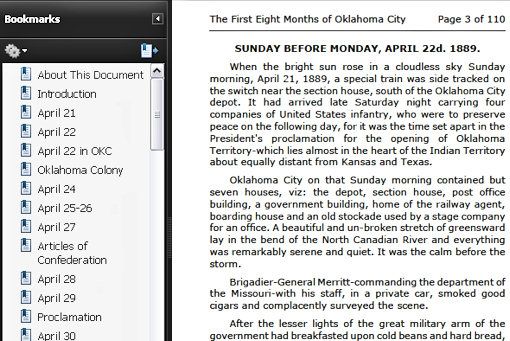
Go To Top
... Click here to read the full article and any comments ...
|














 In 1939 the 1st National Bank published an excellent 64 page booklet called Fifty Years Forward which not only commemorated its 50th anniversary as an Oklahoma City banking institution but also contained lengthy excerpts from "Bunky's" The First Eight Months of Oklahoma City (McMaster Printing Company 1890), a then-contemporary history of Oklahoma City's 1st 8 months, published in 1890. This booklet is one of the neat purchases I made at the Abalache Book Shop on Exchange Avenue a couple of weeks ago.
In 1939 the 1st National Bank published an excellent 64 page booklet called Fifty Years Forward which not only commemorated its 50th anniversary as an Oklahoma City banking institution but also contained lengthy excerpts from "Bunky's" The First Eight Months of Oklahoma City (McMaster Printing Company 1890), a then-contemporary history of Oklahoma City's 1st 8 months, published in 1890. This booklet is one of the neat purchases I made at the Abalache Book Shop on Exchange Avenue a couple of weeks ago.






















